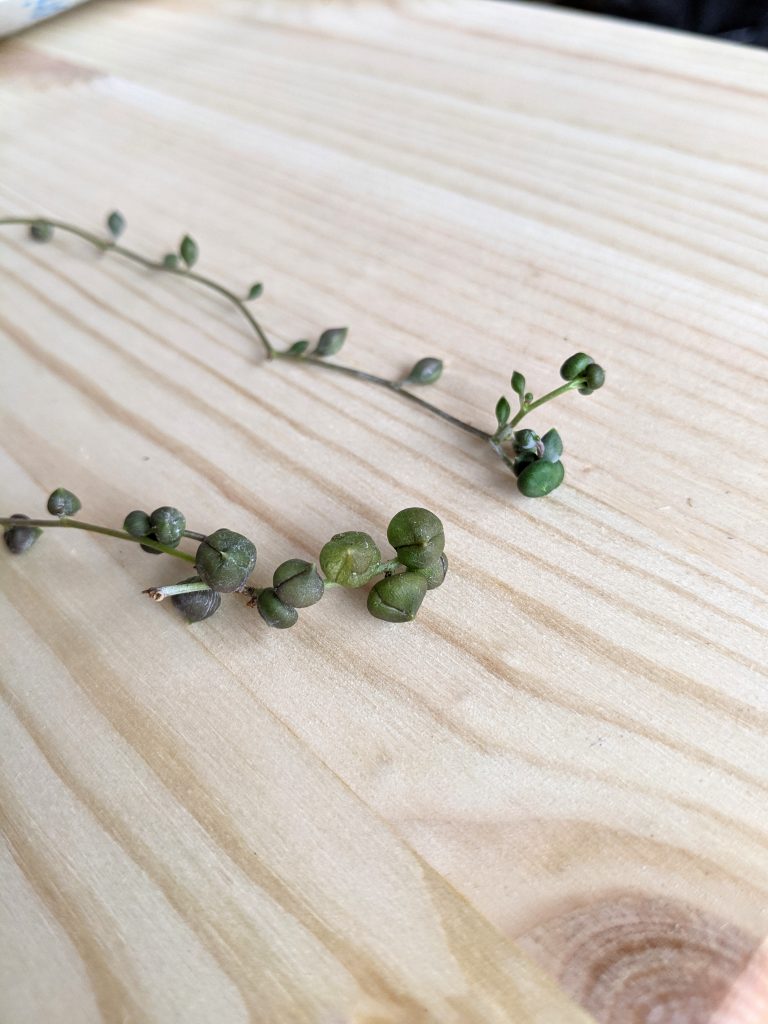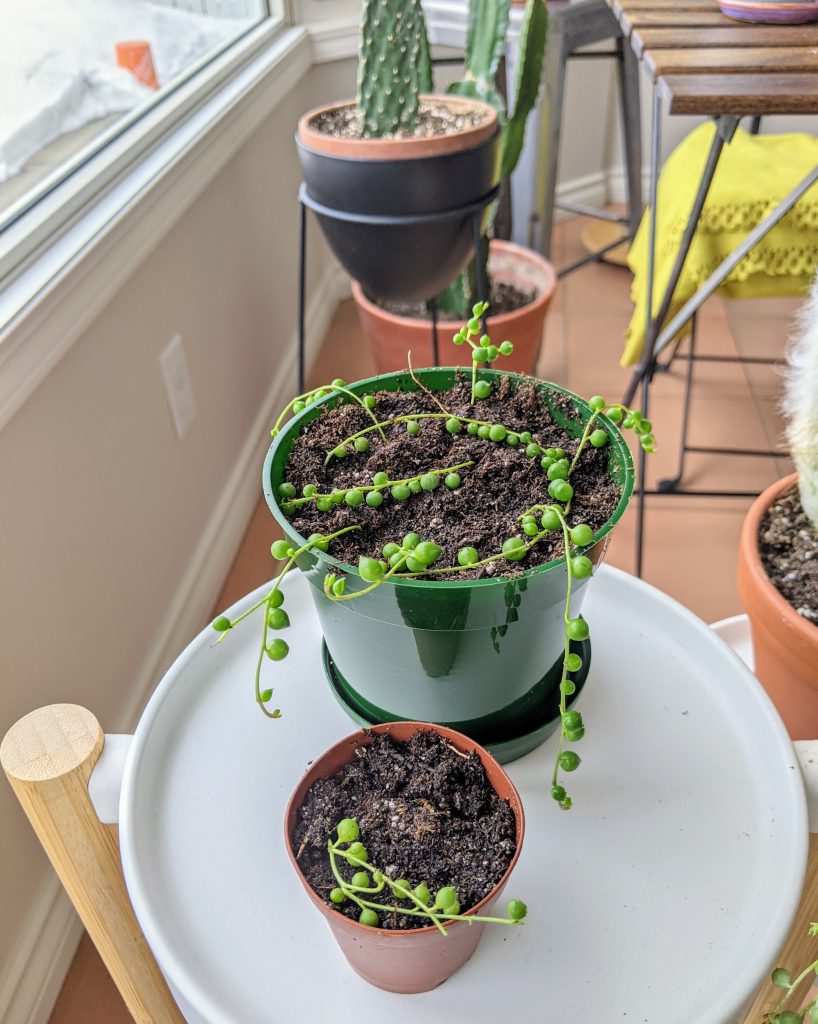It’s no secret that the string of pearls plant is tricky to keep alive and healthy. Once you’ve found the perfect balance of water and sunlight, it will produce elegant cascading pearls. After years of troubleshooting to figure out how to keep my senecio rowleyanus happy, I’ve probably gone through every single problem that you’ll encounter with these plants.
Let’s diagnose the reasons your string of pearls is dying and help you get it back to the thriving and lucious queen that it is.
This post contains affiliate links, which means I may make a small commission if you click through and make a purchase.
How Do You Not Kill a String of Pearls

First, to keep your plant alive and healthy, you need to provide it with perfect growing conditions. This includes:
Bright, indirect light for several hours a day (avoid hot sun).
Don’t water too often (and when you do, make sure it’s a thorough drench).
Use well draining soil and make sure the pot has drainage holes (also make sure the plant isn’t planted too far down in the pot).
Read my entire guide to caring for and keeping your string of pearls care.
Pearls are Mushy and Textured, Yellow or Falling Off

Overwatering is a common reason people (accidentally) kill their string of pearls. They are drought tolerant and can go without water longer than you may think.
Overwatered pearls will go dark and mushy and start to get a weird bumpy texture to them. Sometimes the pearls will even burst.
Pearls that are turning yellow indicate a sign of root rot and have been sitting in soil that is too moist for too long.
In this case, you should gently pull your plant out of the soil and inspect the rest of the root system. It likely needs to dry out for a few days, in which case you can lay it out on a paper towel.
While you’re doing this, you should go through each strand and cut off any that are yellow or turning yellow. You can’t salvage the strands that are rotting.
Repot your plant with new soil and ensure it’s in a pot with drainage holes at the bottom.
A terracotta or clay pot is usually the best choice.
Even better, choose a clay bonsai pot for your string of pearls, as shallow is what they prefer.
But you do have other pot options for your indoor succulents.
If your pearls easily fall off the stems this is also a sign that they’ve been overwatered for too long.
This is also a sign that the strands are hanging too close to a drafty or cold spot in your house.
Try moving it to a more calm spot with plenty of bright, filtered light.
Pearls are Pointed or Becoming Shriveled
If your pearls aren’t round, it’s okay. Oblong-shaped, shrivelled or dehydrated looking pearls are a telltale sign that your plant needs water.
When your senecio needs water, the pearls lose their round shape and the windows start to close. The window (the slit in the middle) is where it absorbs light.
When your plant is thirsty, it closes its window in an effort to stop taking in more light while it preserves moisture.
How to Water Properly
Only water your string of pearls when the soil is completely dry. Your plant will let you know when it needs a drink – the pearls will lose their round shape and start to become pointed.
If you’re unsure if it needs water, you can likely wait a bit longer – they do much better with not enough water than too much.
When you do water, make sure you water thoroughly and all the way through.
Many people prefer bottom watering, which allows the plant to soak up water through its roots and only takes what it needs.
This only works if you have a shallow pot as string of pearls have one of the most shallow root systems.
A good example of a shallow pot is this bonsai pot from Amazon.
You can also top water, but make sure you don’t allow water droplets to sit on the pearls as they can rot easily. Wipe off excess water when you’re done.
String of Pearls is Sparse On Top or Leggy

Is your string of pearls becoming sparse and thinning out on top but has long strands that continue to grow? This can be caused by a number of problems.
Incorrect Light Distribution
First, it may not be getting enough light on top of the plant; this is common when you have it in a hanging planter.
Your string of pearls needs bright indirect light to hit both the trailing strands and the top of the plant.
Try moving your plant a bit lower to allow a more even distribution of light.
Another sign that it’s not getting enough light is if it’s growing ‘leggy.’ This is when the strands are growing long with lots of space in between each pearl.
Top Rot from Incorrect Potting
Another cause of thinning out on top could be due to top rot. String of pearls do not like to be planted too far down in the pot.
Make sure the top of the soil is no more than a quarter to half inch below the rim of the pot.
If it’s any lower than that, the stands and roots do not get enough air flow and start to rot easily. In these conditions, water usually lingers too long and further rot ensues.
Be sure the pot isn’t too big for the size of the plant either. Keep your string of pearls in its nursery pot for at least a month before repotting (you can even go longer if the roots aren’t growing out of the drainage holes).
When you do repot it, make sure the pot is only one inch wider and deeper than what it’s currently sitting in.
The string of pearls plant has one of the most shallow root systems and being placed in a pot that’s too big is one of the most common reasons that causes problems.
And sometimes with an older plant, the trailing strands just get so long that they weigh the plant down and it can’t direct energy into growing new pearls on top.
Get a Full Crown: How to Make it the Top More Full

If you’ve got a sparse looking crown on your string of pearls, you can cut the long stems and plant them right back in the soil.
In fact, when you see full and luscious string plants, it’s because their owners have been constantly doing this over the years.
Snip the bottom of the strands so that they’re at least 4-6 inches long and stick them in the soil.
Make sure there’s at least one node on each cutting. You can’t just randomly snip and place them in the soil.
I like to find 2 or 3 nodes per cutting and plant one node deeper in the soil and allow the other nodes to rest on top of the soil.

You can secure your cutting by inserting a bobby pin to hold the cutting in place until it roots.
String of Pearls Turning Purple or White
Purple Pearls = Sunburn
Pearls that turn purple are a sign of stress from too much sun. They can’t tolerate hot, direct sun and turning dark or purple is a sign of them becoming sunburned.
Moving them to a location with filtered light should help. Wait a few weeks before determining if you need to snip off the burned pearls.
They usually bounce back to life, but wait until they’ve settled into their new space for a few weeks first.

White Pearls = Sunburn, Hard Water or Pests
White pearls are also victims of sunburn and they most likely can’t be recovered. It doesn’t mean your whole plant is toast, though.
Move it away from the hot sun and snip off the sunburned strands or individual pearls.
White pearls aren’t always sunburnt; it could just be mineral residue from your tap water. If that’s the case, you can switch to distilled water or use the bottom watering method.
If your pearls and strands have white fluffy or powdery bits on them, this is a sign of mealybugs which suck the juices out of the pearls.
You’ll probably first notice what looks like tiny pieces of cotton-like spots. Another sign of mealybugs is small droplets of a clear, honeydew substance (this is their excretions).
To get rid of mealybugs on your string of pearls, you should pick off as many as you can and then spray the entire plant with a neem oil solution. For a bad infestation you can spray it with diluted isopropyl alcohol.
Read the full guide for getting rid of mealybugs on your succulents and other plants.
Tried Everything and Nothing Works?
If you’ve had every symptom under the sun and nothing seems to help, your string of pearls could also be at the end of its lifespan.
Senecio rowleyanus aren’t very long-living plants – most do not live past 5 to 10 years, even in optimal conditions.
If this is the case with your plant, take as many healthy cuttings as you can and propagate them to start a new plant (or several).

Stay Green!
Share a pin to your pinterest board or with your Facebook friends!



Thank you for this detailed article. Do you know what it means if the stems are shriveling and drying up but not the leaves?
This probably means it’s lacking some nutrients. I would repot with fresh soil and use a small amount of fertilizer every 2-3 waterings